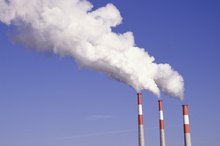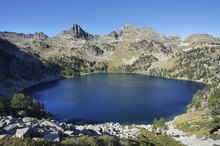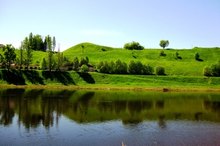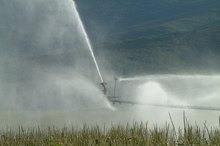The Advantages of Rainfall
Rain, also known as precipitation, involves the condensation of water in the air. When the air can longer hold the weight of the water it falls to the earth in the form of hail, rain, snow or sleet.
Rain is part of the never-ending water cycle, where fallen rain eventually evaporates, becomes stored by clouds and falls to the earth again to repeat the process 1 1. The advantages seen in rainfall contribute to the earth's weather systems, seasons and the survival of all plant and animal life.
Human Life
Humans need a constant source of fresh water to sustain their lives, and this occurs as a direct result of adequate rainfall. The human digestive system needs water to break down solids. Water flushes the human system of toxic substances, by expelling sweat, urine and fecal matter. **Water cushions the human joints, allowing movement without friction.
** Water reduces the human body temperature, helps blood to flow and transport oxygen and nutrients. The lymph system in the human body,composed of water, contains immunities to help fight diseases.
- Humans need a constant source of fresh water to sustain their lives, and this occurs as a direct result of adequate rainfall.
- Water flushes the human system of toxic substances, by expelling sweat, urine and fecal matter.
Plants
Disadvantages of the Greenhouse Effect
Learn More
Plants, trees, grass and flowering shrubs all depend upon rainfall to live and reproduce. Plant roots absorb water and transport it to the leaves and stems, assuring growth from seedlings to mature stages of development. Plants take in carbon dioxide and expel oxygen, as a result of photosynthesis, which supplies the needed oxygen to the atmosphere for animal respiration.
As a result of adequate rainfall, plant roots grow long and sturdy, which enables them to hold the topsoil together. Strong plant roots reduce soil erosion.
- Plants, trees, grass and flowering shrubs all depend upon rainfall to live and reproduce.
- As a result of adequate rainfall, plant roots grow long and sturdy, which enables them to hold the topsoil together.
Natural Water Storage
Rainwater falls to the ground and is absorbed into the soil, reaching locations in the bedrock known as aquifers. Aquifers hold huge volumes of water in the water table. Many man-made wells feed directly from the water table, providing drinking and bathing water.
Water in the aquifers travel though the sedimentary rock to other locations, providing plants and trees with a constant source of water. Huge amounts of rainfall over the Arctic regions drop snow, locking up trillions of gallons of fresh water in the snow sheets and glaciers.
- Rainwater falls to the ground and is absorbed into the soil, reaching locations in the bedrock known as aquifers.
- Water in the aquifers travel though the sedimentary rock to other locations, providing plants and trees with a constant source of water.
Ocean Movement
Advantages & Disadvantages of Gabions
Learn More
Rainfall influences the movement of the oceans by producing fast-moving currents. Collected snow pack in the Arctic and Greenland regions, produced by rain, melt and enter the top loop of the Gulf Stream. The Gulf Stream functions as a conveyor, which transport cooler water from the north to the tropics, where it becomes heated and then travels back to the north to repeat the process. The Gulf current influences Earth's weather systems, responsible for rainfall in some areas and dry, drought-like conditions in others.
- Rainfall influences the movement of the oceans by producing fast-moving currents.
- The Gulf Stream functions as a conveyor, which transport cooler water from the north to the tropics, where it becomes heated and then travels back to the north to repeat the process.
Inundation and Flooding
Inundation and flooding can have very positive effects on farmlands and delta areas. Once such example was Egypt, when heavy rains flooded the Nile River during the inundation period.
The flood waters produced by the seasonal rainfall transported huge quantities of silt over the banks and through the low-lying delta areas. The silt was collected and used as rich fertilizer, resulting in improved crop growth. Many other delta areas of the earth experience the same process and benefit from heavy rainfall.
- Inundation and flooding can have very positive effects on farmlands and delta areas.
- Many other delta areas of the earth experience the same process and benefit from heavy rainfall.
Hydroelectric Plants
Hydroelectric plants use a very old method of producing energy -- they harness the movement of fast-moving rivers or depend upon the gravity of reservoirs, to drive huge turbines. Since the plant's output of energy depends upon the presence of water, rainfall is a necessary factor in keeping enough water volume moving through the pipes and turbines.
Rain supplies all of the needed water volume to run hydroelectric plants, making them pollution free. The rain costs nothing as an energy source. Frequent and adequate rain keeps all of our hydroelectric plants constantly operating.
- Hydroelectric plants use a very old method of producing energy -- they harness the movement of fast-moving rivers or depend upon the gravity of reservoirs, to drive huge turbines.
- Rain supplies all of the needed water volume to run hydroelectric plants, making them pollution free.
Related Articles
References
Writer Bio
Chris Stevenson has been writing since 1988. His automotive vocation has spanned more than 35 years and he authored the auto repair manual "Auto Repair Shams and Scams" in 1990. Stevenson holds a P.D.S Toyota certificate, ASE brake certification, Clean Air Act certification and a California smog license.









